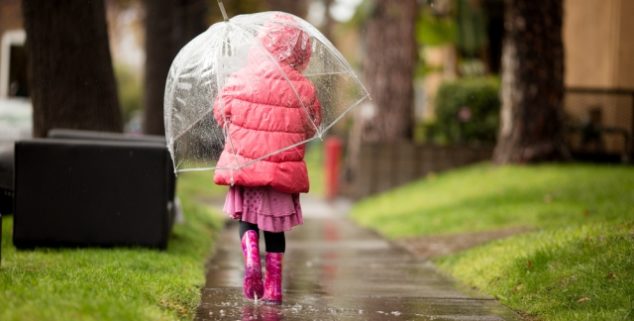News
Amid rains and mudslides, drought concern remains
 A young girl plays in the rain. (Photo: Falon Koontz)
A young girl plays in the rain. (Photo: Falon Koontz)Despite the fierce rains and deadly mudslides that have struck California, water officials are concerned about the possibility of a renewed drought.
But they caution that is too early to tell.
Frank Gehrke, chief of the California Cooperative Snow Surveys Program, measured snowpack levels with a team last week in the bare Phillips Station area of the Sierra Nevadas, about 90 miles east of Sacramento. He didn’t find much.
“We still have three historically wet months ahead of us.”– Mike Anderson
The snow level, closely tracked through the winter, is crucial because when it melts in the spring and summer it provides water to most of California. On Jan. 3, the snow level was only about 24 percent of average
In a statement released by the California Department of Water Resources, Gehrke said the levels “seem a little gloomy,” but areas that had no snow a few weeks ago, now have a few patches.
State Climatologist Mike Anderson is hopeful there is still time for rainfall.
“We still have three historically wet months ahead of us,” Anderson noted in the DWR statement. “There’s still time for the snowpack to build and improve before it begins to melt, which usually starts happening around April 1,” he added.
Several days ago, substantial rains struck the state — Sacramento recorded a record two inches of rain in 24 hours — but the impact of the moisture on the snowpack was indifferent.
Half of California’s annual rainfall occurs in December through February, and about two-thirds of the annual total arrives during December through March, Anderson said.
“The south, stretching from the Carolinas to Southern California, may be a bit more parched than usual.” — Sarah Frecht
Whether there is a drought or not depends on how different areas of the state are affected rather than how much rainfall there is. Janine Jones, interstate resources manager for DWR, said in 2017 that California is a big state and will always experience different conditions in different areas.
In a report published by The Earth Institute at Columbia University, satellite images provided by NOAA show parts of central California and all of southern California likely to have warmer temperatures in January through March of this year.
“The south, stretching from the Carolinas to Southern California, may be a bit more parched than usual,” wrote Sarah Frecht, in an article for Phys.org as part of the report.
In December, the National Oceanic and Atmospheric Administration Jason-3 satellite picked up images of a large mass of colder-than-normal water around the Earth’s equator, a classic sign of La Niña conditions, scientists say.
Historically, these have increased the likelihood of a dry winter for California.
According to maps published by the United States Drought Mitigation Center, southern California is classified as a mix of “abnormally dry,” and “moderate drought” as of Jan. 4.
Not every part of California is completely dry, some state reservoirs have filled up more than their 2017 levels reported last year.
Lake Shasta, California’s largest surface reservoir, now holds 118 percent of its historical average, as of Jan. 3. One year ago, Shasta’s reservoir was just 50 percent of its average.
Four NOAA atmospheric river observatories reside in California: McKinleyville, Bodega Bay, Point Sur and Santa Barbara.
Lake Oroville, the State Water Project’s largest reservoir, is holding more water today than it was last year.
Roughly half of California’s water supply comes from so-called “atmospheric rivers,” which are like tunnels in the sky, transporting most of the water vapor out of the tropics.
These tunnels move with the weather and carry an amount of water vapor equivalent to the average flow of the mouth of the Mississippi River, NOAA officials said. When these rivers reach landfall, they release in the form of rain or snow.
Four NOAA atmospheric river observatories reside in California: McKinleyville, Bodega Bay, Point Sur and Santa Barbara. There are 15 NOAA snow-level radar stations throughout the United States, 13 of which are in California, one in Oregon, and one in Plymouth, Vermont.
State officials urge Californians to conserve water as much as possible.
Doing laundry and showering use an average of 196 gallons of water per day, according to Save Our Water. Loading the dishwasher fully before washing can save up to 5 to 15 gallons per load. Installing a high-efficiency toilet can also save up to 19 gallons per day, per person.
DWR believes California needs to acquire better precipitation prediction systems in place. Currently, predictions are about 70 percent accurate, he says.
“Current technology and computer modeling an tell us what our weather might be weeks into the future, but we’re essentially blind to what the weather will be beyond the two-week mark,” said Grant Davis, former DWR director.
“That’s why we are putting in so much effort to improving medium and long-range modeling,” he added.
Want to see more stories like this? Sign up for The Roundup, the free daily newsletter about California politics from the editors of Capitol Weekly. Stay up to date on the news you need to know.
Sign up below, then look for a confirmation email in your inbox.

Leave a Reply